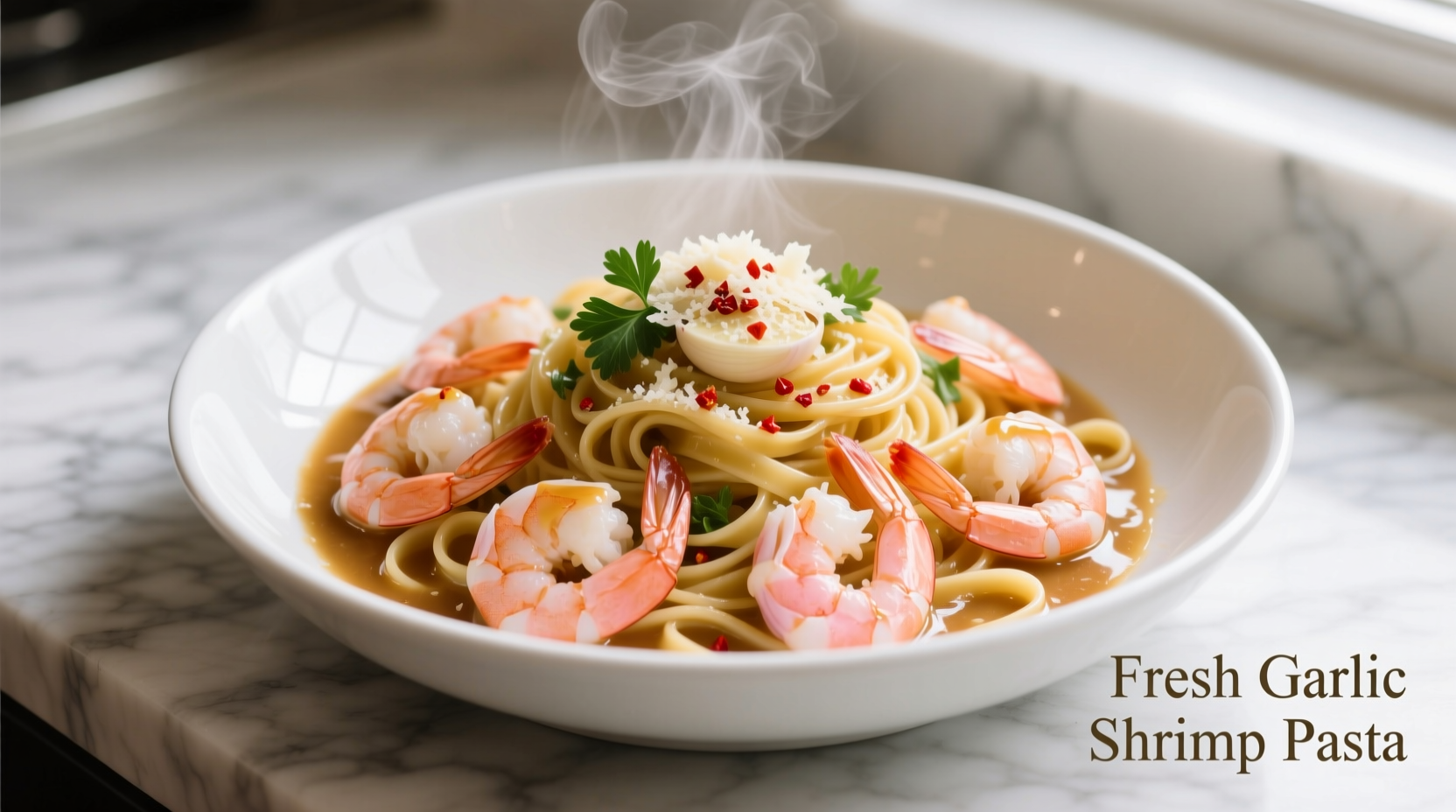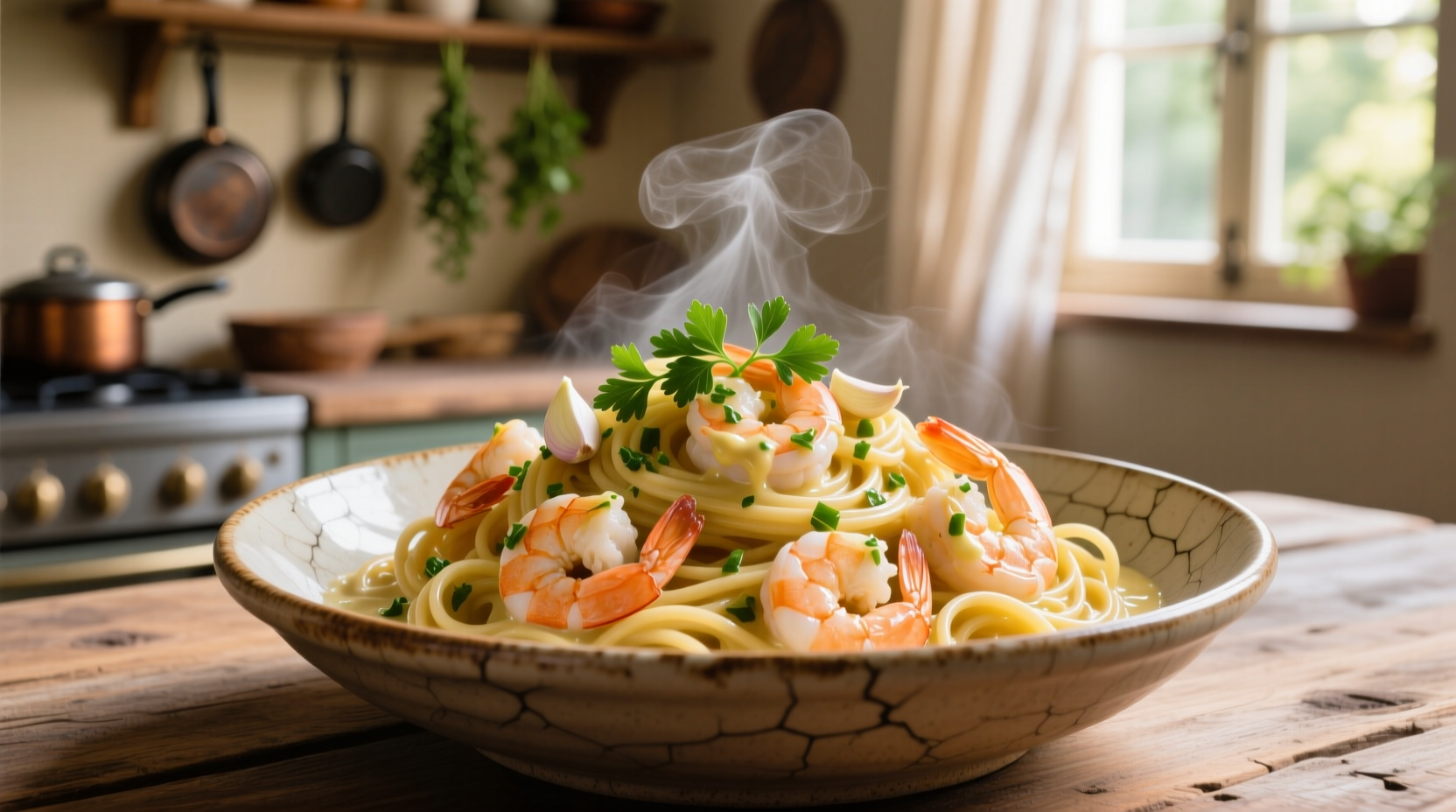Get a restaurant-quality garlic shrimp and pasta ready in 20 minutes with this foolproof recipe. Perfectly cooked shrimp, al dente pasta, and a rich garlic-infused sauce create a balanced meal that serves 4 people with just 15 minutes of active cooking time. This authentic preparation avoids common mistakes like rubbery shrimp or bland sauce while delivering maximum flavor.
There's nothing quite like the aromatic sizzle of garlic hitting hot oil, followed by plump shrimp curling into perfect C-shapes as they cook. This classic Italian-inspired dish has become a weeknight staple for good reason—it's fast, affordable, and endlessly adaptable while maintaining that sophisticated restaurant-quality taste. But achieving perfect results requires understanding the delicate balance between properly cooked seafood and perfectly textured pasta.
The Secret to Perfect Garlic Shrimp Every Time
Many home cooks struggle with shrimp, ending up with either undercooked seafood or rubbery, overcooked results. The key lies in understanding shrimp's narrow cooking window. According to the U.S. Food and Drug Administration, shrimp should reach an internal temperature of 145°F (63°C), but visual cues are more practical for home cooking.
When cooking shrimp for pasta:
- Start with room-temperature shrimp (remove from refrigerator 15 minutes before cooking)
- Pat shrimp completely dry with paper towels
- Cook in a single layer without overcrowding the pan
- Flip only once when edges turn opaque
- Remove from heat just before fully cooked (they'll continue cooking off-heat)

Why This Garlic Shrimp Pasta Recipe Works
Unlike many simplified versions that sacrifice depth of flavor, this method builds complexity through technique rather than excessive ingredients. The magic happens in the "fond"—those delicious browned bits left in the pan after cooking the shrimp. When deglazed with white wine or broth, these caramelized particles dissolve into the sauce, creating restaurant-quality depth without complicated steps.
| Pasta Shape | Why It Works | Best Sauce Pairing |
|---|---|---|
| Linguine | Long strands capture sauce while providing textural contrast to shrimp | Classic garlic-olive oil base |
| Spaghetti | Thin strands work well with lighter, broth-based sauces | Lemon-garlic broth variation |
| Fusilli | Spirals trap small shrimp pieces and herbs | Creamy garlic variations |
| Penne | Hollow centers hold chunkier sauce elements | Tomato-garlic shrimp version |
Step-by-Step Cooking Process
Preparation Phase (5 minutes)
Gather these simple ingredients for authentic garlic shrimp pasta:
- 12 oz (340g) linguine or spaghetti
- 1 lb (450g) large shrimp, peeled and deveined
- 4-5 garlic cloves, thinly sliced
- 1/2 cup high-quality olive oil
- 1/2 cup dry white wine or seafood broth
- 1/4 cup fresh parsley, finely chopped
- 1 lemon (zest and 2 tbsp juice)
- Red pepper flakes (to taste)
- Salt and freshly ground black pepper
Cooking Sequence (15 minutes)
- Cook pasta in well-salted water until al dente, reserving 1 cup pasta water before draining
- Pat shrimp dry and season lightly with salt and pepper
- Heat olive oil in large skillet over medium-high heat
- Add garlic and red pepper flakes, sautéing until fragrant (30 seconds)
- Add shrimp in single layer, cooking 1-2 minutes per side until pink
- Remove shrimp from pan, leaving oil and garlic behind
- Add wine/broth to deglaze pan, scraping up browned bits
- Reduce liquid by half (2-3 minutes)
- Add drained pasta, shrimp, lemon zest, and 1/4 cup pasta water
- Toss vigorously over low heat until sauce emulsifies (1-2 minutes)
- Finish with lemon juice, parsley, and additional pasta water as needed
Historical Context: How Garlic Shrimp Became an Italian Classic
While often associated with Italian cuisine today, garlic shrimp pasta has evolved significantly over time. Historical food records from the Encyclopædia Britannica show that:
- 14th-16th centuries: Garlic was considered peasant food in Italy, used primarily for its medicinal properties rather than culinary appeal
- Late 1800s: Southern Italian immigrants brought simple garlic-shrimp combinations to America, where ingredients were more abundant
- 1950s-60s: Post-war prosperity made seafood more accessible, transforming simple coastal dishes into restaurant specialties
- 1980s-present: Emergence of "lighter" Italian-American cuisine popularized garlic shrimp pasta as a quick weeknight option
Common Mistakes to Avoid
Even experienced cooks make these critical errors when preparing garlic shrimp pasta:
- Overcooking garlic: Garlic burns at 350°F (175°C), turning bitter. Always add it to warm (not smoking) oil
- Crowding the pan: Causes shrimp to steam rather than sear, preventing proper browning
- Adding cold shrimp to hot pan: Temperature shock makes shrimp tough—bring to room temperature first
- Skipping pasta water: The starchy liquid is essential for creating a cohesive sauce that clings to pasta
- Using dried herbs: Delicate seafood pairs best with fresh herbs for bright flavor notes
When This Dish Shines (And When to Choose Something Else)
Understanding the context boundaries helps you serve this dish at its best:
- Ideal for: Weeknight dinners, casual entertaining, hot weather meals (no heavy oven use), seafood-focused menus
- Less suitable for: Formal occasions requiring multiple courses, when serving guests with shellfish allergies, winter comfort food cravings
- Perfect pairings: Crisp white wines like Pinot Grigio, simple green salad, crusty bread for soaking sauce
- Storage limitations: Best eaten immediately—shrimp becomes rubbery when reheated, though sauce can be made ahead
Flavor Variations Worth Trying
Once you've mastered the classic preparation, these authentic variations expand your repertoire:
- Lemon-Enhanced: Double the lemon zest and add capers for a brighter, coastal Italian interpretation
- Creamy Version: Finish with 1/4 cup heavy cream and Parmesan for a richer texture (add after deglazing)
- Tomato Twist: Add 1/2 cup cherry tomatoes in the last 2 minutes of cooking for freshness
- Spicy Arrabbiata: Increase red pepper flakes and add a splash of Calabrian chili paste
- Herb-Forward: Substitute half the parsley with fresh basil or oregano for regional Italian variations
Nutritional Profile and Dietary Adaptations
A standard serving (1/4 of recipe) contains approximately:
- 520 calories
- 28g protein
- 65g carbohydrates
- 15g fat (mostly heart-healthy monounsaturated from olive oil)
For dietary modifications:
- Gluten-free: Use high-quality gluten-free pasta and increase reserved pasta water by 25%
- Lower-carb: Substitute half the pasta with spiralized zucchini (add in final minute of cooking)
- Dairy-free: Recipe is naturally dairy-free (avoid Parmesan variations)
- Lower-sodium: Use low-sodium broth and reduce added salt by half
Perfecting Your Technique: Pro Tips
Professional chefs achieve consistent results through these often-overlooked details:
- Garlic thickness matters: Thin slices cook evenly without burning, while minced garlic requires constant attention
- Shrimp size consistency: Use 26/30 count shrimp for uniform cooking (30-35 shrimp per pound)
- Wine selection: Choose a wine you'd actually drink—avoid "cooking wine" which contains salt and preservatives
- Emulsification technique: Toss pasta vigorously over low heat to help starches bind with oil for a cohesive sauce
- Finishing temperature: Remove from heat when sauce coats the back of a spoon (around 160°F/71°C)











 浙公网安备
33010002000092号
浙公网安备
33010002000092号 浙B2-20120091-4
浙B2-20120091-4